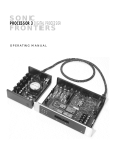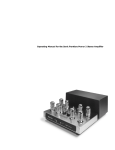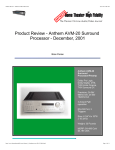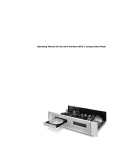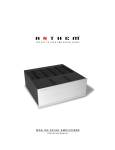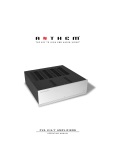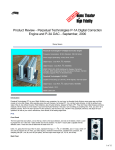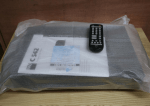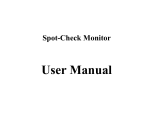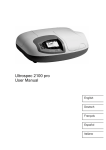Download Anthem Audio THE SONIC FRONTIERS LINE SERIES Specifications
Transcript
T H E S O N I C F R O N T I E R S L I N E S E R I E S P R E A M P L I F I E R S OWNER’S MAN UAL L I N E L I N E L I N 1 2 E P R E A M P L I F P R E A M P L I F I E R 3 P R E A M P L I E R A N D I F I E P O W E R R A N S U P P L Y D P O W E R S U P P L Y OPERATING MANUAL FOR THE SONIC FRONTIERS LINE SERIES PREAMPLIFIERS We at Sonic Frontiers hope you will derive many years of listening pleasure with your new LINE Series Preamplifier. This Operating Manual contains important information regarding the operation and care of these Preamplifiers. Be sure to read this manual carefully and follow these instructions in order to keep them performing and sounding their best. Please contact Sonic Frontiers if you have any questions - a Customer Service Representative will be pleased to assist you. CONTENTS Unpacking ........................................................................................................1 Operation, Connection and Control Diagrams ........................................................2 Control and Connection Functions ........................................................................4 Preamplifier Set-up ..............................................................................................6 Tube Insertion ....................................................................................................6 Chassis Placement ..............................................................................................7 Connecting External Equipment ............................................................................7 Power Connections ............................................................................................8 Home Theatre Accessories....................................................................................8 Powering On and Startup Procedures ....................................................................9 Remote Control Functions ..................................................................................10 Tube Replacement ............................................................................................11 Trouble Shooting ..............................................................................................11 Fuse Location ..................................................................................................11 Safety Instructions..............................................................................................12 Warranty ........................................................................................................12 Technical Specifications ....................................................................................13 Remote Control Battery Replacement ....................................................................14 This symbol is intended to alert the user to the presence of uninsulated “dangerous voltages” within the product’s enclosure that may be of sufficient magnitude to constitute a risk of electric shock to persons. This symbol is intended to alert the user to the presence of important operating and maintenance (servicing) instructions in the literature accompanying the appliance. UNPACKING At this point we assume that you have successfully opened the box flaps and found this manual. These boxes were designed to ensure the safe transport of the LINE Series Preamplifiers. Sonic Frontiers strongly recommends the storage of these boxes in a safe dry place. In the event that the Line 1, Line 2, or Line 3 may have to be shipped in the future, the original boxes are the best means for the protection and safety of the preamplifier during transportation. Here is a chart listing what you will find in the box: Tube Complement • Line 1 and Line 2 • Line 3 Phillips Screwdriver Screws Power Cord Cotton Gloves 6 - 6922 10 - 6922 2 - 6GH8A 1 18 or 36* 1 1 pair Extra Fuses 2 Line 1, Line 2, or Line 3 Preamplifier 1 *Line 2 or Line 3 Power Supply 1 Preamplifier Top Cover 1 *Power Supply Top Cover 1 Remote Control 1 Warranty Card 1 Operating Manual 1 If after your inspection of the contents there is a discrepancy, contact your dealer or Sonic Frontiers immediately. * Only for Line 2 or Line 3 owners. OP E RA T ION, C O NNE CT I ON S AN D C ON TRO L F U NC TI O NS LINE 1, LINE 2, AND LINE 3 FRONT PANEL Note: This diagram applies to ALL LINE Series preamplifiers, as they all have identical front panel functions. A B C D E F G H I J K L Figure 1 - Line 1, Line 2, and Line 3 Front Panel LINE 1 REAR PANEL M N O P Q R S T U V W Q R S T U V W Figure 2 - Line 1 Rear Panel LINE 2 X AND LINE 3 REAR PANEL O P Figure 3 - Line 2 and Line 3 Rear Panel 2 O PER A TI O N, CO NN E CT IO NS AN D CO NT R OL FUNC T I ON S LINE 2 POWER SUPPLY REAR M N AND C ON T’ D FRONT PANELS Y Z Figure 4 - Line 2 Power Supply Rear and Front Panels LINE 3 POWER SUPPLY FRONT PANEL Z Figure 5 - Line 3 Power Supply Front Panel LINE 3 POWER SUPPLY REAR PANEL Y N Figure 6 - Line 3 Power Supply Rear Panel AA CONTR OL AND CONNE CTION FUNCTIO NS A- XLR Balanced Input Buttons (BAL 1, BAL 2) These buttons will select a balanced input signal connected to one of the XLR Balanced Inputs. When selected the LED display window will light BAL 1 or BAL 2. Input volume levels can be preset and saved in memory. See “K” below. Note: Whenever you select a new input, there is a ramp up in volume as the preamp resets to your saved level. The duration of the ramp up is dependent on the output level. B- Single-Ended Input Buttons (SE 1 - SE 4) These buttons will select a single-ended input signal connected to that specific single-ended input. The selected input will be displayed in the LED display window. Preset input volume levels can be saved in memory. See “K” below. ly and safely. Depending upon the methods used in producing the recording, the user may prefer listening to a given recording in either phase position. G- LED Display Window - The Display window gives the operating status of the Preamplifier. There are four levels of light intensity available plus OFF. This is adjustable only with the remote control DISP (display) button. See page 10. C- Tape Input Button - This button toggles the Tape monitor ON/OFF and will display TAPE in the LED display window. All other preamp display functions remain active and the same. H- Balance Buttons - These buttons control the relative balance of the left and right channels to compensate for any discrepancies caused by speaker placement, source imbalance, etc. The balance between the left and right channel can be changed by pressing the BALANCE LEFT or BALANCE RIGHT button. When the left balance button is pressed, the RIGHT channel will be decreased in 0.5dB increments. When the right balance button is pressed the LEFT channel will decrease in 0.5 dB increments. To reset to an equal balance either adjust until the volume levels are equal again or select any other input - then reselect this input to recall the preset (default) settings. For setting default levels see “K” below Note: Whenever you select this function there is a ramp up in volume as the pre- Note: To reset the volume levels to equal values on both channels, simply press Note: Whenever you select a new input, there is a ramp up in volume as the preamp resets to your saved level. The duration of the ramp up is dependent on the output level. amp resets to your saved level. The duration of the ramp up is dependent on and hold the Mode button for a minimum of 1.5 seconds. The volume level the output level. will then revert to the higher of the two channels. D- SSP (Surround Sound Processor) Input Button This button selects the Surround Sound Processor (SSP) input signal. When selected, SSP will light in the LED display window and all other displays will blank indicating that all preamp functions are completely disabled. The SSP signal is directly connected to all the preamp’s single-ended and balanced outputs. Note: The XLR outputs become a single-ended signal. Non-inverting polarity (0˚) is automatically selected. The only way to deselect SSP mode is to press the SSP button a second time. I- Mode Button - The LINE Series Preamplifiers can operate in one of two modes: MONO or STEREO. Only the MONO mode is indicated in the LED display window. Switching between MONO and STEREO is done by pressing the mode button on the front panel or remote control. Mono is available for any input (balanced or single-ended), including TAPE OUT. Note: A secondary feature of the Mode button is its ability to reset the channel balance to an equal setting on both channels. Simply press and hold the Mode button for 1.5 seconds to perform this operation. Note: Whenever you deselect this function there is a ramp up in volume as the preamp resets to the level of the previously selected input. The duration of the ramp up is dependent on the output level. E- HeadRoom™ Headphone Output - Here you can insert the plug from your headphones into the front panel headphone jack. When headphones are plugged in MUTE will be displayed in the LED display window. All functions remain operational. All the linestage main outputs will be MUTED except the TAPE. Use the volume control to set a desired level. When the Headphone plug is removed the volume levels will all return to their preset or default settings. Note: Whenever you remove your headphone plug there is a ramp up in volume as the preamp resets to the default input and saved level. The duration of the ramp up is dependent on the output level. Note: When headphones are plugged in, the output to your amplifier is muted (as indicated in the front panel LED display window). However a second MUTE function is still available (by pressing the MUTE button) for the headphones. Note: Headphones will not work when SSP mode is selected. F- Phase Button - This button allows the user to invert the system phase polarity by 180˚ (relative to the input signal) easi4 J- Mute Button - The Line Stage main output can be muted by pressing the MUTE button. When the signal is muted it will be indicated in the LED display window. The TAPE OUT function is not affected. A secondary “volume control” MUTE function is still available while listening with headphones. Note: Whenever you deselect this function there is a ramp up in volume as the preamp resets to your saved level. The duration of the ramp up is dependent on the output level. K- Precision Balanced Volume Attenuator Control This continuous rotation knob controls the balanced attenuator. It gives precise control over left and right channel levels in 0.5 dB steps - 191 levels of attenuation from 00.0 to 95.5. Turning the control knob clockwise will increase the volume. Once the end of each range (00.0 or 95.5) is reached, the knob will continue to rotate without any further change in volume setting a reverse in direction will immediately begin changing the volume level in the other direction. Setting Default Volume Levels - Volume/Balance levels for individual inputs (except SSP) can be pre-set and stored in memory. C ONNECTION S A ND CONT ROL F UNC TIONS To store a volume/balance setting, adjust the volume and balance to the desired level then press and hold the button corresponding to that input until the LED window blanks (about 4 seconds), then release. Once the level is saved in memory for each given input, it will be recalled every time that input is selected again. Levels saved in memory will not be affected by unplugging the power from the unit. Note: The volume default for all inputs is factory set at 30.0. L- Standby Button - If AC power has been interrupted or shut off, the unit will remain in PRE-STANDBY mode for 10 seconds, while it begins it’s turn on cycle again (Refer to Powering On & Start-up Procedures, on page 9). After 10 seconds, the unit can be powered on by pressing the STANDBY button. The preamplifier will remain in MUTE mode for 22 seconds and after that the selected default input will be set to BAL 1, display brightness to maximum and the volume will be set to the preset value for BAL 1. When the preamplifier is turned on for the first time the volume will be set to 30.0. In STANDBY mode, power is still supplied to the tube filaments, but the high voltage power supplies for the audio circuitry are not yet on. M- Power Switch - In the “ON” position, this switch turns the Power Supply (Line 2) or Preamplifier (Line 1) on. In the “OFF” position, the Power Supply and Preamplifier are off. Note: Be sure the Power Supply Umbilical Cord (Y) that is attached to the Power Supply chassis is plugged into the Preamplifier chassis and the AC power cord is plugged in at both ends before the Power Switch (M) is turned on. Failure to do this may cause damage to the Preamplifier. N- Detachable AC Power Cord Socket - Plug the Preamplifier or Power Supplies’ (whichever applies to your unit) AC Power Cord into this socket (see Figure 12). The LINE Series Preamplifiers are factory set for the correct operating voltage for the area in which it is sold (see rear of preamp or power supply for voltage setting). If a different operating voltage is required, please contact an authorized Sonic Frontiers dealer, distributor or the factory directly. O- Relay Trigger - A normally “open” contact is supplied for the control of an external device. This contact “closes” only when OPERATE mode is selected (see figure 14 for more details). P- XLR Balanced Outputs (Sets 1&2) - These outputs are balanced and should be used when connecting outputs to another balanced unit such as one of the Sonic Frontiers POWER Series amplifiers. These two outputs, as with the single-ended outputs (Q), allow for easier biamping and greater flexibility when dealing with components such as electronic crossovers, etc. As with all outputs and inputs on these CONT’D Preamplifiers, the left channel is situated on the upper row of connectors and the right channel is on the lower row. Q- Single Ended RCA Outputs (Sets 1&2) - These unbalanced outputs (single-ended) should be used when connecting the outputs to another single-ended unit. These two outputs, as with the XLR outputs (P), allow for easier biamping and greater system flexibility. R- RCA Single-Ended Tape Output - These actively buffered outputs connect to a tape deck with single-ended inputs. Only the balanced and single-ended inputs are available for the Tape output. S- RCA Single-Ended Tape Input - This input accepts a single-ended input connection from a tape source. T- RCA SSP Input - This input accepts the left and right channel outputs from your Surround Sound Processor (SSP), completely bypassing all functions of your preamp. U- RCA Single Ended Inputs (Sets 1-4) - These inputs accept single-ended input connections from sources such as a CD player, Tuner, Phono Stage, etc. V- XLR Balanced Inputs (Sets 1&2) - These inputs accept any balanced input connections from a balanced source. This will achieve the highest possible sonic performance. W- I.R. Jack - This jack can be used to plug in an external Infra Red Repeater (see figure 13 for more details). X- Power Supply Input Socket (Line 2 and Line 3 only) - Plug the Power Supply Umbilical Cord from the Power Supply into this socket. Simply rotate the plug until you feel a connection being made with the socket.The plug will then insert easily into the socket when pushing the connection together. Screw on the locking ring allowing it to “click” to secure the connection (see figure 11) Note: Do not attempt to unscrew the Power Supply Umbilical Cord from the Power Supply. Y- Power Supply Umbilical Cord (Line 2 & Line 3 only) - This Umbilical Cord exits the Power Supply to plug into the Power Supply Input Socket (X) (see Figure 8 for connection). Note: Do not attempt to unscrew the Power Supply Umbilical Cord from the Power Supply. Z- Power Supply LED (Line 2 and Line 3 only) - This green LED lights when the Power Supply is plugged in and switched on. AA- Power Button (Line 3 Only) - This button serves the same purpose as the Power Switch (M) on the Line 1 and Line 2. In the “on” position (IN), the Power Supply is on. In the “off” position (OUT), the Power Supply and Preamplifier are off. P RE A MPL IF IE R S ET -U P You are now ready to begin setting up your preamplifier. INSERTION OF THE TUBES WARNING DISCONNECT the AC Detachable Power Cord from the Line 1 Main Chassis or Line 2 & Line 3 Power Supply before removing the Preamplifier chassis cover. LV1 V1 LV2 V2 LV3 V3 Please read and follow these instructions carefully. Great care was taken in the testing, selection and matching of the supplied tubes in order to ensure proper operation of the unit. Failure to follow these instructions will cause these preamps to suffer in performance and sound quality. The Line 1 and Line 2 are supplied with six 6922 (6DJ8-type) tubes, while the Line 3 is supplied with ten 6922 (6DJ8-type) tubes and two 6GH8A tubes individually boxed. The 6GH8A tubes in the Line 3 must be placed in the locations marked LV2 and V1 for the preamp to function. Figure 7 - Line 1 tube installation locations. LV1 V1 LV2 V2 LV3 V3 WARNING Do not adjust any controls inside any of the preamps - shown in Figures 7,8 and 9. These controls have been factory set for the optimum performance (both sonically and electrically) of the LINE Series Preamplifier. Do not adjust these controls - doing so will degrade the performance of the Line Series Preamplifier. They may only be adjusted using specialized test equipment that only authorized service depots, distributors or the Sonic Frontiers factory have for this purpose. 1. In order to install the tubes, use the supplied Phillips screw driver and remove the top cover of the main chassis. For your convenience, only a few screws were installed at the factory to facilitate the easy removal of the Top Covers. [Note: The main chassis has the volume control knob, and the LED display window on it.] 2. When handling the tubes, it is recommended the cotton gloves provided be worn to prevent skin oils from depositing on the glass surface. Find the tubes appropriate for your preamplifier, boxed in the packaging storage compartment. 3. Inspect the tubes for code markings. They will be coded individually, each with one of the following codes: LV1 - LV3, and V1 - V3 (on the Line 1 and Line 2). The tubes for the Line 3 are labeled LV1 - LV6 and V1 - V6. Figure 8 - Line 2 tube installation locations. LV1 LV2 V1 V2 LV3 LV4 V3 V4 LV5 LV6 V5 V6 4. Now inspect the printed circuit board (PCB) above the tube sockets in the Line 1, Line 2 or Line 3 preamplifier for the codes matching the codes on the tubes (See Figures 7,8 and 9 for further clarification). Figure 9 - Line 3 tube installation locations. 6 PREAMPLIFIER SET-UP CONT’D 5. Take the LV1 tube and inspect the pins noting the large space between two of the pins. This space will align with the same larger space between two of the pin holes on the socket. Insert the LV1 tube into the LV1 tube socket, making sure all pins and pin holes are aligned (see Figure 10). Do not force the tube into the socket. Rock the tube gently while pushing slowly until the tube is firmly seated. Repeat this step for the remaining tubes, LV2 tube to the LV2 tube socket etc. V1 tube to the V1 tube socket, V2 tube to the V2 tube socket etc. The units must be placed on a hard flat surface (NOT on carpet), preferably side by side or on separate shelves with plenty of unobstructed space all around the preamp to allow for free movement of air for proper cooling. Do not operate these preamplifiers in an enclosed cabinet - overheating will result. Allow at least 6” (15 cm) of clear space all around the Preamplifier chassis for proper ventilation. CONNECTING EXTERNAL EQUIPMENT If you have XLR Balanced connections available on your source units a connection made with these inputs will yield optimum sonic performance. Connect the left channel output of the source unit to the left channel input of the LINE Series preamplifier, and the right channel output to the right input. Note: The XLR configurations are as follows: Note the larger space between two of the pins and holes for proper alignment of tube and socket. Figure 10 - Tube pin alignment with the socket. Pin#1- Ground Pin#2- Positive Pin#3- Negative Connector Body - Chassis ground V P Input (female) Output (male) Back Panel View 6. Once all the tubes are installed, no other adjustments or installation of any other parts is necessary. Replace the Top Cover, and using the Phillips screw driver, fill all the screw positions with the screws provided. There are extra screws provided in case you misplace a few. Note: Partially install the screws, then go back and tighten them all. Do not over-tighten. 7. You have now completed the preliminary steps of setup before your listening pleasure will begin. LINE SERIES If the balanced outputs are not applicable for use, the RCA single-ended (unbalanced) outputs should be used when connecting the source unit to the RCA single-ended inputs on the LINE Series preamplifier, left channel to left, right channel to right. There are also two optional connections that can be made for Custom Home Theatre Installations. These are the I.R. Jack and the Relay Trigger. They are discussed in more detail on page 8. PRE AMP LIFIER AND P OWE R SUP PLY CH ASSIS P LACEMENT Under no circumstances should the Line 2 or Line 3 Power Supply be placed directly on top of the Preamplifier, or the Preamplifier placed on top of the Power Supply. This will not allow adequate ventilation, and overheating will result. The feet of the LINE Series preamplifiers are temperature sensitive and may deform if exposed to excessive heat. 7 PREAMPLIFIER SET-UP CONT’D POWER CONNECTIONS HOME THEATRE ACCESSORIES (OPTIONAL) Once all input and output signal connections are made, you can begin to make the power connections. There are two external connections provided for customization of you home theatre set-up. These are the I.R Jack (Infra Red) and the Relay Trigger. Both of these connections accept a 3.5 mm stereo plug as shown below. LINE 2 AND LINE 3 UMBILICAL CORD CONNECTIONS As the Line 2 and Line 3 each have an external power supply, an additional connection is required. Plug the Power Supply Umbilical cord (Y) from the rear of the Power Supply into the Power Supply Input Socket (X) on the rear of the preamplifier as shown below in figure 11. I.R. JACK (INFRA RED) The LINE Series preamplifiers allow you to install an external Infra Red Repeater (user supplied). This will allow you to operate this preamp from a remote location or different room in your house via an Infra Red remote control. See specifications on page 13. User Supplied X Y Tip Ring + – I.R. Jack (W) Figure 11 - Rotate the connector (Y) on the receptacle (X) until you feel the notches align to ridges, and then push together. Turn locking ring clockwise until it “clicks” indicating it is locked. Figure 13 - I.R. Jack and 3.5mm stereo plug connection RELAY TRIGGER PREAMPLIFIER POWER CONNECTIONS Plug the detachable Power Cord into the Power Cord socket (N) on the back of the LINE 1 chassis or power supply (LINE 2 and LINE 3). The LINE Series preamplifiers are configured for the line voltage in the country in which they are sold. See the shipping box or the rear of the chassis for voltage settings. If a different operating voltage is required, please contact an authorized Sonic Frontiers dealer or the factory directly. If you have any automated devices, they can be activated by connecting here. The Relay Trigger is activated when the STANDBY button is depressed (switching to OPERATE mode), causing an internal, isolated relay contact (normally open) to close. This in turn can be used to control the operation of your automated devices (such as, turning off your listening room lights, drawing your window curtains closed, cueing a projection TV screen or projector to be lowered, etc.). See specifications on page 13. User Supplied Sleeve N Relay Trigger (O) Figure 12 - Align socket pins to corresponding holes and push together. Figure 14 - Relay Trigger and 3.5mm stereo plug connection POWERING ON & STARTUP PROCEDURES Do not attempt to turn on your preamplifier until ALL prior steps have been completed. 1. The Line 1 or Line 2 Power Switch (M), or Line 3 power button (AA) should be switched to the ON position. The LED display window will initially remain blank for 10 seconds. During this time (PRE-STANDBY), power is being applied to the tube filaments. After 10 seconds six (6) dots will light up in the LED display window. The preamp is now in STANDBY mode. 4. When you have selected your desired input (BAL 1, BAL 2, or SE1-SE4) you can change the phase polarity from 0˚ to 180˚, change the mode from STEREO to MONO, MUTE the output, and select TAPE concurrently. The maximum number of functions displayed in the LED window at any time is five, plus the volume levels. Note: The Line 2 and Line 3 Power Supply LED (Z) will light the moment the power switch is turned on. 2. You may now push the STANDBY button (L), and the output MUTE will also be displayed in the LED window. The unit will remain muted for a further 22 seconds, while the preamp stabilizes, before going into OPERATE mode. 5. When you select SSP (Surround Sound Processor) mode it will illuminate in the LED display window, and all other functions in the LED window will blank and are completely disabled. The Surround Sound Processor signal is directly connected to all the preamps balanced and single-ended (unbalanced) outputs. When SSP is deselected the preamp will return to the previously selected input and level (not the default settings). SHUTTING OFF POWER WARNING 3. After 22 seconds, the preamp will be in OPERATE mode, with the default BAL 1 input indicated and the left and right numeric LED’s will display your preset volume levels. All displays are at maximum brightness, and the volume/balance will be set to your saved levels. If you are turning the preamp on for the first time, the volume will be set to 30.0. Always turn “off” your power amp first, before turning off the preamp. Failure to do so may cause a transient pulse to be delivered through the amplifier to the speakers. When shutting off power from the preamplifier, it must always be put into STANDBY mode first. Then turn the power off via the Power Switch (M) on the Line 1 & Line 2, or the Power Button (AA) on the Line 3. It is recommended that you leave the preamplifier in STANDBY mode when unattended, rather than shutting off the main power completely. This is done by simply pressing the STANDBY button. However, if the preamplifier will not be used for an extended period of time, you should shut off the main power completely. 9 R EM OT E CO NT R O L FUN CT I ON S 1 2 3 4 5 6 7 8 9 10 11 12 13 1- Dual Infra Red Emitters - These emitters transmit the coded data from the remote control to the LINE Series main chassis front panel. Do not obstruct the infra red beam. 8- Mute - The preamp can be muted by pressing the mute button. When the signal is muted, “MUTE” will be indicated in the LED display window. When coming out of MUTE the volume will ramp-up to the selected level (at a rate dependent on this level). 2- Volume Increase - This button controls the increase in volume. Pressing it will increase the volume in 0.5dB increments. Pressing and holding changes the volume continuously at approximately 6dB/second, after a 0.3 second delay. Note: When switching between inputs, the volume will ramp up to the preset level. While this is happening, the volume can be muted. When this occurs, the LED window will display the volume level reached at that point in the volume ramp-up cycle - not the final preset level. 3- Volume Decrease - This button controls the decrease in volume. Pressing it will decrease the volume in 0.5dB increments. Pressing and holding changes the volume continuously at approximately 6dB/second, after a 0.3 second delay. 4- Balance Left - This button controls the balance between the left and right channels. Pressing it will decrease the volume in the RIGHT channel 0.5dB. Pressing and holding changes the volume continuously at approximately 6dB/second, after a 0.3 second delay. Note: To reset the volume levels to equal values on both channels, simply press and hold the Mode button for a minimum of 1.5 seconds. The volume level will then revert to the higher of the two channels. 5- Balance Right - This button controls the balance between the left and right channels. Pressing will decrease the volume in the LEFT channel 0.5dB. Pressing and holding changes the volume continuously at approximately 6dB/second, after a 0.3 second delay. Note: To reset the volume levels to equal values on both channels, simply press and hold the Mode button for a minimum of 1.5 seconds. The volume level will then revert to the higher of the two channels. 6- Input Select - This button scrolls through the six inputs, then repeats. Pressing it will scroll through the inputs from BAL1 to SE4, then repeats - but NOT TAPE or SSP. Note: Whenever you select a new function there is a ramp-up in volume as the preamp resets to your saved level. The duration of the ramp up is dependent on the output level. 7- Mode Select - This button allows you to toggle between STEREO and MONO mode. Only “MONO” mode is indicated in the LED display window. Note: A secondary feature of the Mode button is its ability to reset the channel balance to an equal setting on both channels. Simply press and hold the Mode button for 1.5 seconds to perform this operation. 9- DISP (Display) - This button allows you to toggle between 4 levels of display brightness plus OFF. Pressing the button once will increase the brightness by one level. Pressing and holding will provide a continuous change. Note: The default turn on setting is the maximum brightness level. Although the setting can be changed to four other levels (one of which is off), when any function is selected, the display brightness changes to maximum for three seconds, then reverts back to the previously selected display brightness level. 10-Phase - The signal phase polarity relative to the input signal can be changed between 0˚ or 180˚ by pressing the phase button. Only 180˚ phase is indicated in the LED display. Phase change is allowed for all inputs except SSP. When SSP input is selected, the signal will be set to 0˚ automatically (default setting). 11-SSP (Surround Sound Processor) - This button will select or deselect the SSP input. When selected, all other display items will be blanked and phase will be set to 0˚. When SSP is deselected, the display items will turn back on and return to the previous input and volume level (not the default settings). See page 4 (D) 12- STBY (Standby) - When this button is pressed, STANDBY mode can be selected or deselected. When selected, the LED Display will be OFF except for six (6) digit dots, at one step lower than maximum brightness. When the unit is powered on from STANDBY mode, it will be in MUTE for 22 seconds. The LED display window will show MUTE during this period of time. After the 22 second MUTE, the preamplifier will be fully operational (OPERATE mode), and revert to the default BAL 1 input. 13-Tape -This button will toggle the TAPE input ON or OFF. All other preamp functions remain active and in their previous condition. MO D E F UN CTI O N When the MODE button is depressed the STEREO inputs from both the left and right channel are combined or blended to MONO operation. This gives a reduction in “separation” from approximately 100dB down to approximately 8dB between STEREO channels and is desirable for reducing apparent separation between stereo speakers, or for establishing the the proper spacial effect for more natural reproduction using stereo headphones. This is the normal position for reproduction of MONO analog LP recordings with a STEREO phono cartridge. The MODE (Stereo/Mono) button is not designed to provide two channel reproduction from a single output mono device, such as a mono tuner or mono tape recorder unless a suitable Y connector is inserted in the signal path from the mono device to the two stereo inputs. NOTE: To further explore the reasoning for 8dB separation in mono mode, most stereo recordings contain a certain degree of “summing” and “differencing” between channels, plus signals which are pan potted or have modified phase relationships to each other. This spacial information may occur naturally in the recording process by acoustic leakage between mic. channels, or be purposely added/enhanced by the recording engineer during the record or mixdown stage. This is done in order to provide the desired spacial effect. If these signals are summed to mono with no separation of channel information, the in-phase portion of the combined signal is boosted, the out of phase portion is attenuated, and some of the signal remains at the same level. This has the undesired effect of altering the timbre of the recording. Thus the true mono summation has the negative effect of destroying the recording’s tonal balance, front to back depth perspective, etc. Note that “true” Mono recordings do not contain these phase cancellations etc., and thus maintain their tonal balance in ALL modes. 11 TROUBLE SHOOTING If the LINE Series Preamplifier is not functioning properly, please check each of the following: WARNING Fuse DISCONNECT the AC Detachable Power Cord from the Line 1 Main Chassis or Line 2 & Line 3 Power Supply before beginning troubleshooting. 1. Check that the Power Supply Umbilical Cord (Y) is connected correctly to the Power Supply Input Socket (X). Next, ensure that the AC Detachable Power Cord is plugged into the Preamplifier’s or Power Supply’s Detachable Power Cord Socket (N) and is connected to a live source of AC power. For instance, if using a power bar, check that the bar is turned on. 2. Be sure that the Power Switch (M) on the rear of the Line 1 chassis or the Line 2 Power Supply chassis are in the “ON” position. On the Line 3 preamplifier make sure that the Power Button (AA) on the front of the Power Supply is in the “ON” position (IN). Figure 15 - The Fuse in the Line 1 is located in the right rear corner of the preamplifier chassis. 3. Check that the proper input has been selected with the Selector Buttons (A-D) on the Preamplifier chassis. 4. Ensure that the preamp is not in MUTE or STANDBY mode, or still in the 32 (10 + 22) second warm-up/turn-on cycle. Fuse 5. Check that the AC Line Fuse inside the Power Supply chassis (or Preamp chassis in the Line 1) is good. Be sure to first unplug the AC Detachable Power Cord from the Power Supply before removing chassis covers to check the fuse. For fuse locations see figures 15-17. To remove the fuse, simply unscrew the fuse holder and remove the fuse. If the fuse has blown, the thin metal conductor will have melted and the glass may appear “smoked”. If the fuse has blown, replace with a fuse of the same type and rating (See specifications for fuse ratings). 6. If the LED display window shows six horizontal bars when in OPERATE mode, be sure you have the tubes of the proper type plugged in the correct positions. Figure 16 - The Fuse in the Line 2 is located in the right rear corner of the power supply chassis. 7. Check to be sure that all the tubes are correctly and firmly seated in their tube sockets and that all nine contact pins are inserted in each socket (i.e. no pins are bent over). Verify that an orange glow is visible from inside of each tube when the unit is on. Fuse 8. If you are still experiencing any difficulty with your Line Series Preamplifier, contact your dealer or distributor for assistance. REPLACEMENT OF THE TUBES Sonic Frontiers strongly discourages non-factory replacement of the tubes. The tubes supplied are measured, selected, and matched in balanced pairs - channel to channel and triode section to triode section - for optimum performance. Problems arising from non-SFI supplied tubes will not be covered under warranty. If replacement tubes are needed, desired or required contact Sonic Frontiers for assistance. Figure 17 - The Fuse in the Line 3 is located in the right rear corner of the power supply chassis. SAFETY INSTRUCTIONS 1. Ventilation - Although your LINE Series Preamplifier generates only nominal heat in use, be sure that the ventilation slots in the top cover have at least 6” of unobstructed air space above them. Do Not obstruct the bottom vent by operating the preamplifier on carpet or with the rubber feet removed. 2. Water and Moisture - This product should not be used near water. Do not expose this product to rain or moisture to prevent fire or shock hazard. 3. Heat - This product should be situated away from heat sources such as radiators, heat registers, stoves, or other appliances which produce heat. LIMITED FIVE YEAR WARRANTY Sonic Frontiers, Inc. warrants to the purchaser that each Line Series Preamplifier and Power Supply is free of manufacturing defects for a period of five (5) years from the date of purchase. This five (5) year limited non-transferable warranty excludes all vacuum tubes, which we warrant for a period of twelve (12) months. To receive this warranty, the original purchaser must complete and mail to Sonic Frontiers, within thirty (30) days from the date of purchase, the enclosed Warranty Registration Form. Sonic Frontiers, Inc. will then validate the warranty to the original purchaser. This warranty is subject to the following conditions and limitations: 1. Warranty applies only to the original purchaser. 4. Power Sources - This product should be connected to an AC power source of the proper rated voltage. The original shipping containers will stipulate the AC voltage this unit can operate with correctly. 5. Cleaning - A regular dusting with a soft, non-abrasive cloth will generally keep the finish of the faceplate and chassis looking like new. At no time should you allow any liquid to come in contact with the LINE Series Preamplifier and Power Supply; it may run into the electronic circuitry and cause damage which will not be covered under your warranty. 6. Servicing - Do not open this product. No user serviceable parts inside. Refer servicing to an authorized service technician. 7. Non-Use Periods - The power cord of this product should be unplugged from the outlet when left unused for an extended period of time. 8. Do not remove Preamplifier or Power Supply covers while unit is connected to an AC power source. 2. This warranty is void and inapplicable if the product has been handled other than in accordance with the instructions in this Owner’s Manual, abused or misused, damaged by accident or neglect or in being transported, or the defect is due to the product being tampered with, modified or repaired by anyone other than Sonic Frontiers, Inc. or an authorized Sonic Frontiers repair depot. 3. Warranty does not cover normal maintenance. 4. Sonic Frontiers, Inc. shall not be responsible in any way for consequential or indirect damages or liabilities resulting from the use and operation of the product covered herein or resulting from any breach of this warranty or any implied warranty relating to said product. During this period, Sonic Frontiers, Inc. will repair or replace any defective components free of charge. A Return Authorization Number (RAN) is required before any product is returned to our factory for any reason. This number must be visible on the exterior of the shipping container(s) for Sonic Frontiers to accept the return. PACKING MATERIALS We recommend that you retain all of the packing material and shipping boxes for your LINE Series Preamplifier and Power Supply. They are custom designed to prevent shipping damage from occurring. Sonic Frontiers, Inc. will accept no responsibility for any damage occurring to a LINE Series Preamplifier and Power Supply that is shipped in packing material other than the original Sonic Frontiers packing material. Units shipped to us without a Return Authorization Number or without a visible RAN on the exterior of the shipping container(s) will be returned to the sender, freight collect. Units to be repaired by Sonic Frontiers, Inc. must be sent shipping and insurance prepaid by the original purchaser in the original packing material. A returned product should be accompanied by a written description of the defect. Repaired units will be returned by Sonic Frontiers, Inc. shipping and insurance prepaid. DISCLAIMER OF LIABILITY Under no circumstances does Sonic Frontiers, Inc. assume liability or responsibility for injury or damages sustained in the use or operation of this equipment or for damages to any other equipment connected to it. Sonic Frontiers, Inc. reserves the right to make design changes or improvements without the obligation to revise prior versions. All specifications are subject to change without notice. All other warranties or conditions either written, verbal, expressed or implied are void. Note: In foreign markets (anywhere outside of Canada and the USA), the warranty is supplied by the authorized International Distributor. Exact terms and conditions may vary. 13 T EC H NI CAL S PE C IF I CAT I ON S 14 LINE 1 T EC HN I CAL SPE CI FI CAT IO NS LI NE 2 T EC HN I CAL SPE CI FI CAT IO NS Frequency Response 2 Hz to 250 kHz -0.5 dB > 500 kHz -3.0 dB at 2V RMS output Frequency Response 2 Hz to 250 kHz -0.5 dB > 500 kHz -3.0 dB at 2V RMS output THD & N < 0.01% from 20 Hz to 20 kHz Balanced < 0.01% Unbalanced (single-ended) Output at 2V RMS THD & N < 0.01% from 20 Hz to 20 kHz Balanced < 0.01% Unbalanced (single-ended) Output at 2V RMS Gain 18 dB @ 1 kHz (balanced) 12 dB @ 1 kHz (single-ended/unbalanced) Gain 18 dB @ 1 kHz (balanced) 12 dB @ 1 kHz (single-ended/unbalanced) Input Impedance 21k ohms - balanced Input Impedance 21k ohms - balanced Output Impedance 300 ohms balanced output 150 ohms single-ended (unbalanced) Output Impedance 270 ohms balanced output 135 ohms single-ended (unbalanced) Maximum Input 8.0 VRMS maximum (balanced) 4.0 VRMS (single-ended/unbalanced) Maximum Input 8.0 VRMS maximum (balanced) 4.0 VRMS (single-ended/unbalanced) Rated Output 2 VRMS (balanced) 1 VRMS (single-ended/unbalanced) Rated Output 2 VRMS (balanced) 1 VRMS (single-ended/unbalanced) Maximum Output Voltage 56 VRMS at 1% THD (balanced output) Maximum Output Voltage 56 VRMS at 1% THD (balanced output) Noise < 50µV unweighted wideband noise* Approx. 25µV IHF A-weighted noise (balanced) -98 dB A-weighted below a 2 VRMS output Noise < 50µV unweighted wideband noise* Approx. 25µV IHF A-weighted noise (balanced) -99 dB A-weighted below a 2 VRMS output Stereo Separation (Crosstalk) > -100 dB @ 1kHz relative to 2V RMS output Stereo Separation (Crosstalk) > -100 dB @ 1kHz relative to 2V RMS output Tube Complement 6 - 6922 (6DJ8 types) Tube Complement 6 - 6922 (6DJ8 types) Fuse Requirements (1) 1.0 A slow-blo (110-120VAC countries) .5A slow-blo (220-240VAC countries) Fuse Requirements (1) 1.0 A slow-blo (110-120VAC countries) .5A slow-blo (220-240VAC countries) Power Requirements 80VA Operate 40VA Standby Power Requirements 80VA Operate 40VA Standby Dimensions (each chassis) 19” Wide x 14.25” Deep x 4.5” High (48 cm x 36 cm x 11.5 cm) Dimensions (each chassis) 19” Wide x 14.25” Deep x 4.5” High (48 cm x 36 cm x 11.5 cm) Net Weight Approx. 24 lbs (11 kg) - unpacked Net Weight Approx. 33 lbs (15 kg) - unpacked Relay Trigger (Contacts) 30ma AC or DC 30V max. isolated from chassis via 3.5 mm stereo jack Relay Trigger (Contacts) 30ma AC or DC 30V max. isolated from chassis via 3.5 mm stereo jack Infra Red Jack Maximum input voltage 12Vp-p 3.5 mm stereo jack Infra Red Jack Maximum input voltage 12Vp-p 3.5 mm stereo jack TEC HNI C A L SP EC I FIC A TI O NS CONT’D LI N E 3 TE CH NIC AL SP EC IFIC ATI ON S Frequency Response THD & N* Gain 2 Hz to 250 kHz +/- 0.5 dB > 1 MHz -3.0 dB at 2 VRMS output < 0.01% from 20 Hz to 20 kHz Unbalanced (single-ended) or Balanced output at 2 VRMS 18 dB @ 1 kHz (balanced) 12 dB @ 1 kHz (single-ended/unbalanced) REMO TE C ONTRO L TEC HN ICA L SPECIFICATIONS Infra Red Wavelength 890nm (nanometers) Battery 2 AAA 1.5V Dimensions 3” Diameter X 1 1/8” H Weight .1395 Kg (.31 lbs) Input Impedance 21k ohms - balanced Output Impedance 90 ohms balanced output 45 ohms single-ended Maximum Input 8.0 VRMS maximum (balanced) 4.0 VRMS (single-ended) Rated Output 2 VRMS (balanced) 1 VRMS (single-ended) REMOT E CO NT RO L BAT TER Y R EPL A CEM ENT Maximum Output Voltage 56 VRMS at 1% THD (balanced output) To replace the remote control batteries, unscrew the top of the remote from the base and insert batteries as shown below. Noise < 50µV unweighted wideband noise* Approx. 22µV IHF A-weighted noise (balanced) -100 dB A-weighted below a 2 VRMS output Stereo Separation (Crosstalk) > -100 dB @ 1kHz relative to 2V RMS input Tube Complement 10 - 6922 (6DJ8 types) 2 - 6GH8A Fuse Requirements (1) 2A/250V slow-blo (110-120VAC countries) 1A/250V slow-blo (220-240VAC countries) Power Requirements 135VA Operate 75VA Standby Dimensions (each chassis) 19” Wide x 14.25” Deep x 4.5” High (48 cm x 36 cm x 11.5 cm) Net Weight Approx. 60 lbs (27.5 kg) - unpacked Relay Trigger (Contacts) 30ma AC or DC 30V max. isolated from chassis via 3.5 mm stereo jack Infra Red Jack Maximum input voltage 12Vp-p 3.5 mm stereo jack Note: All measurements performed with an Audio Precision System Two test center. “*” Indicates measurement determined within an 80kHz bandwidth. Due to Sonic Frontiers desire to continually improve its products, specifications are subject to change without notice. 15 We at Sonic Frontiers are sure that you will derive many years of listening pleasure with your new LINE Series Preamplifier and Power Supply. This Owner’s Manual contains important information regarding the operation and care of the LINE Series Preamplifiers. Be sure to read this manual carefully and follow these instructions in order to keep it looking, operating and sounding its best. Sonic Frontiers can be reached from 9:00 a.m. to 5:00 p.m., Eastern Standard Time, or 24 hours a day by facsimile. 2790 Brighton Road, Oakville, Ontario, Canada, L6H 5T4 Telephone: (905) 829-3838 Facsimile: (905) 829-3033 E-Mail [email protected] Web Site: http://www.sonicfrontiers.com


















